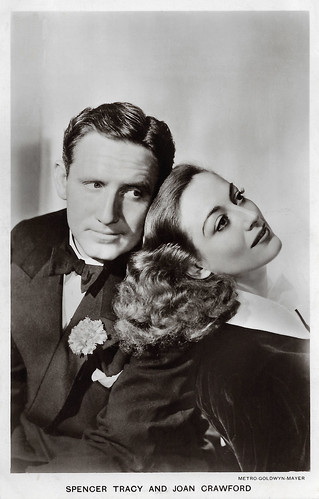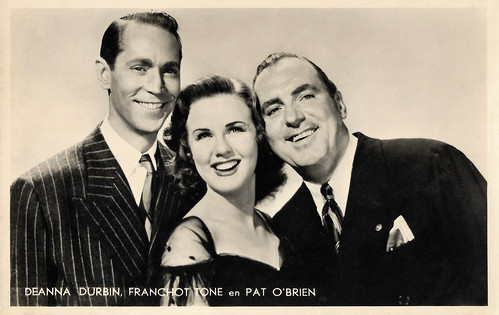
British postcard by John Horn Ltd., Colour Printers, London and Glasgow. Photo: Bolton's-Mutual. Frank Borzage.

French postcard by Cinémagazine Edition (CE), Paris, no. 821. Photo: Fox. Janet Gaynor and Charles Farrell in Lucky Star (Frank Borzage, 1929).

British postcard in the Film Partners series, London, no. P 12. Photo: Sally Eilers and James Dunn in Bad Girl (Frank Borzage, 1931).

German postcard by Ross Verlag, no. 9640/1, 1935-1936. Photo: Paramount. Marlene Dietrich and Gary Cooper in Desire (Frank Borzage, 1936).

British postcard by Art Photo, no. 164. Photo: George Hurrell / Metro-Goldwyn-Mayer. Spencer Tracy and Joan Crawford in Mannequin (Frank Borzage, 1937).
Three classic romantic dramas
Frank Borzage was born Frank Borzaga in 1894 in Salt Lake City, Utah. His father, Luigi Borzaga, was from Roncone in Trentino, then Austria-Hungary, and his mother, Maria Borzaga née Ruegg, was from Zurich, Switzerland. The family immigrated to the U.S. in Pennsylvania, where his father worked as a coal miner for a time.
The family then headed west to Wyoming and then to Salt Lake City, where Frank was born. Borzage was one of 14 children, eight of whom survived childhood. He was the brother of actor Danny Borzage and assistant director Lew Borzage. As a child, Borzage became interested in acting, and while a teenager, he took a job mining silver near Park City to save funds to attend a drama school in Salt Lake City.
Frank worked with a touring company, eventually graduating to acting. He entered films as an actor in Westerns and comedy shorts in 1912, alternating leading roles with character parts as villains. His directorial debut came in 1913 with the short silent drama The Mystery of Yellow Aster Mine (1913) starring Wallace Reid. He continued to work as an actor until 1917. Borzage was a successful director throughout the 1920s. He worked under contract at Fox, 1925-1932; at Warner Brothers (1934-1937); and at MGM (1937-1942).
Borzage reached his peak in the late silent and early sound era. Absorbing visual influences from German director F. W. Murnau, who was also resident at Fox at this time, he developed his own style when he directed Janet Gaynor and Charles Farrell in three classic romantic dramas: Seventh Heaven (1927), Street Angel (1928) and Lucky Star (1929). The enormous success of Seventh Heaven established Gaynor and Farrell as a screen couple and earned them the title 'America's Favourite Lovebirds'. The film contained all the elements that would become characteristic of his later films: a seamless blend of sentimentality and romance, realistic elements from the lives of 'ordinary people', and a lot of emotion.
Borzage became, practically overnight, the most important director of the Fox Studios. Gaynor won the first-ever Best Actress Academy Award for 7th Heaven (1927) and Street Angel (1928), and Borzage was the very first filmmaker to win an Oscar for Best Director in 1929, along with Lewis Milestone. In the early days of the award, the distinction between a drama (Frank Borzage for Seventh Heaven) and a comedy (Lewis Milestone for Two Arabian Knights) was still made.

Italian postcard by G.B. Falci, no. 122. Photo: Autrey / Fox. Charles Farrell and Janet Gaynor in Seventh Heaven (Frank Borzage, 1927).

Belgian postcard by Ed. journal Weekblad Cinéma, Antwerp. Charles Farrell in 7th Heaven (Frank Borzage, 1927).

British postcard by Film Weekly. Photo: Paramount. Gary Cooper, Helen Hayes and Jack La Rue in A Farewell to Arms (Frank Borzage, 1932).

British postcard by Film Weekly. Photo: Paramount. Gary Cooper and Helen Hayes in A Farewell to Arms (Frank Borzage, 1932), based on Ernest Hemingway's homonymous novel (1929).

British postcard by Film Weekly. Photo: United Artists. Leslie Howard and Mary Pickford in Secrets (Frank Borzage, 1933).
Visually striking films with a lyrical appeal
Frank Borzage directed four Best Picture Oscar nominees: 7th Heaven (1927), the drama Bad Girl (1931), A Farewell to Arms (1932) with Gary Cooper and Helen Hayes, and the classic musical Flirtation Walk (1934) starring Dick Powell. In 1932, Borzage won the Oscar for Best Director for the second time, for Bad Girl. The romantic drama A Farewell to Arms (1932), set against the backdrop of World War I, was based on Ernest Hemingway's 1929 novel of the same name and is considered one of his best films.
Many of Borzage's films combine romanticism with spirituality, or feature the lives of lovers imperilled by adversity, usually turbulent socio/political events, for example, the First World War, the Great Depression or the rise of fascism. Borzage worked with many major Hollywood stars of the time. Spencer Tracy starred in about five of his films. Gary Cooper, Robert Taylor, Joan Crawford and Margaret Sullavan also featured in his work on several occasions.
In 1936, he had the opportunity to direct Marlene Dietrich in Desire. On the film set, the actress found Gary Cooper again, six years after the colonial adventure film Morocco (Josef von Sternberg, 1930). Borzage was noted for his technical skills. His films often had a lyrical appeal and were visually striking. He was especially effective in matching mythical subjects with innovative camera work and lighting. With the drama The Mortal Storm (1940), Borzage achieved one of the rare anti-Nazi Hollywood films released before the United States became involved in World War II, with James Stewart playing the only inhabitant of a Bavarian town who did not sympathise with rising Nazism.
During World War II, Borzage recorded the musical Stage Door Canteen (1943). Special about this film was the roles and cameos of numerous famous actors. The place of action was the Stage Door Canteen, where soldiers could celebrate before having to leave for the front. After World War II, Borzage's success began to wane. Still worth mentioning were The Spanish Main (1945), a mild satire on the pirate film, and the poetic Film Noir Moonrise (1948), his only film that could still count on critical acclaim.
It was only ten years later that he resumed his film activities and delivered his last film, the sandal film The Big Fisherman (1959), dedicated to the life of Peter. Borzage was married to Juanita Scott, Edna Skelton and Rena Rogers. In 1962, he won a D.W. Griffith Award for 'outstanding contributions in the field of film direction'. Frank Borzage died of cancer in 1962 in Hollywood, California. He is interred at Forest Lawn, Glendale, CA., in the Garden of Everlasting Peace.

German postcard by Ross Verlag, no. 9437/2, 1935-1936. Photo: Paramount. Marlene Dietrich in Desire (Frank Borzage, 1936).

British postcard in the Film Partners series, London, no. P 230. Photo: George Hurrell / Metro-Goldwyn-Mayer. Spencer Tracy and Joan Crawford in Mannequin (Frank Borzage, 1937).

German postcard by Ross Verlag, no. A1821/1, 1937-1938. Photo: Metro Goldwyn Mayer. Margaret Sullavan and Robert Taylor in Three Comrades (Frank Borzage, 1938). Collection: Marlene Pilaete.

Belgian postcard by Les Editions d'Art L.A.B., Bruxelles (Brussels), no. 2012. Photo: Metro Goldwyn Mayer. Kathryn Grayson and Van Heflin in Seven Sweethearts (Frank Borzage, 1942).

Belgian postcard by Nieuwe Merksemsche Chocolaterie S.P.R.I., Merksem (Anvers), no. B 21. Photo: Metro Goldwyn Mayer. Kathryn Grayson and Van Heflin in Seven Sweethearts (Frank Borzage, 1942).

Dutch postcard by J.S.A. (J. Sleding, Amsterdam. Photo: F.B.O. - M.P.E. / Universal. Deanna Durbin, Franchot Tone and Pat O'Brien in His Butler's Sister (Frank Borzage, 1943).

Portuguese postcard by Postais Krohn, Porto. Deanna Durbin and Franchot Tone in His Butler’s Sister (Frank Borzage, 1943). Collection: Marlene Pilaete.

Dutch postcard by J. Sleding N.V., Amsterdam (J.S.A.), no. S 68. Photo: Universal International. Photo: Ginger Rogers in Magnificent Doll (Frank Borzage, 1946).

Spanish postcard. David Niven and Ginger Rogers in Magnificent Doll (Frank Borzage, 1946).

Italian postcard by B.F.F. Edit, no. 3589. Photo: Dear Film. Victor Mature in China Doll (Frank Borzage, 1958).
Sources: Wikipedia (English, Dutch, and German) and IMDb.
No comments:
Post a Comment